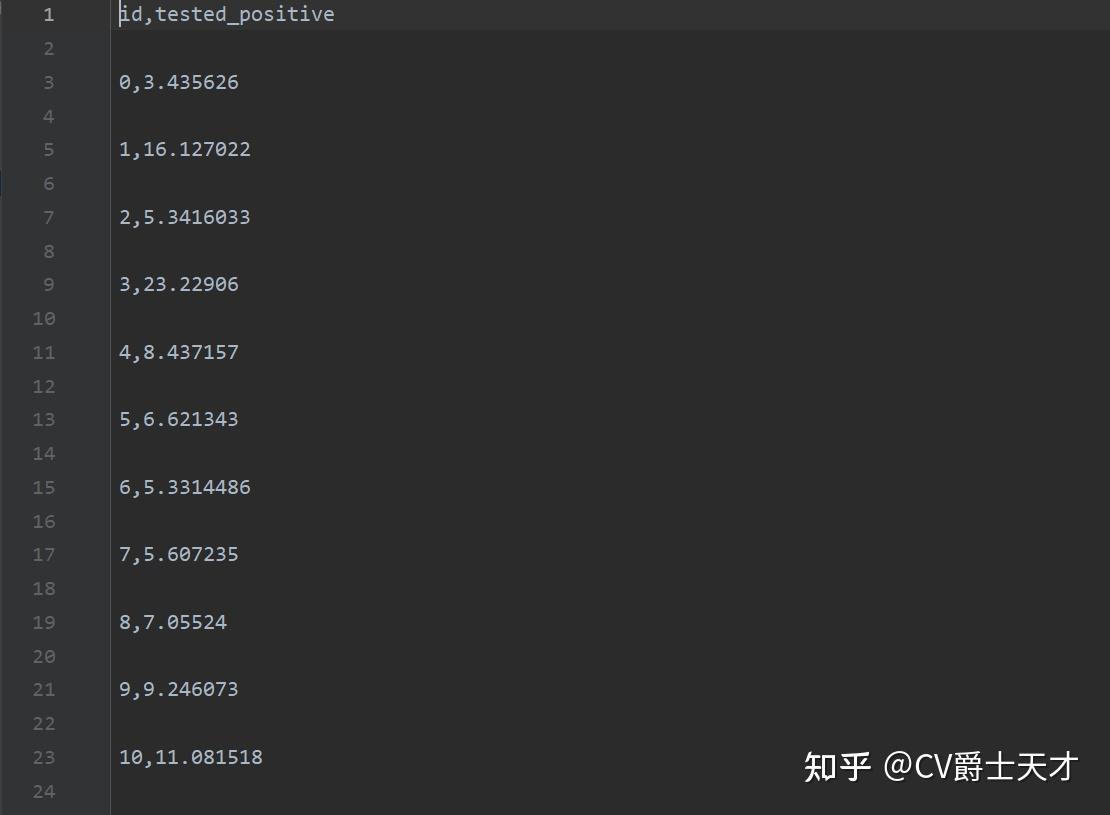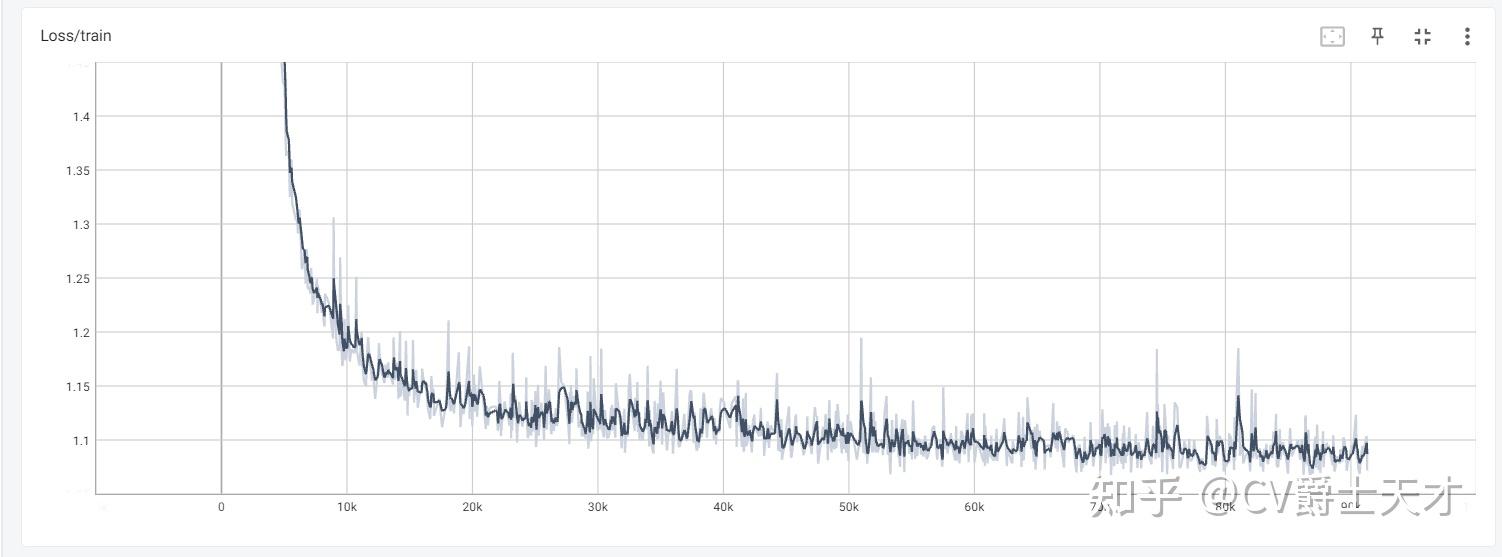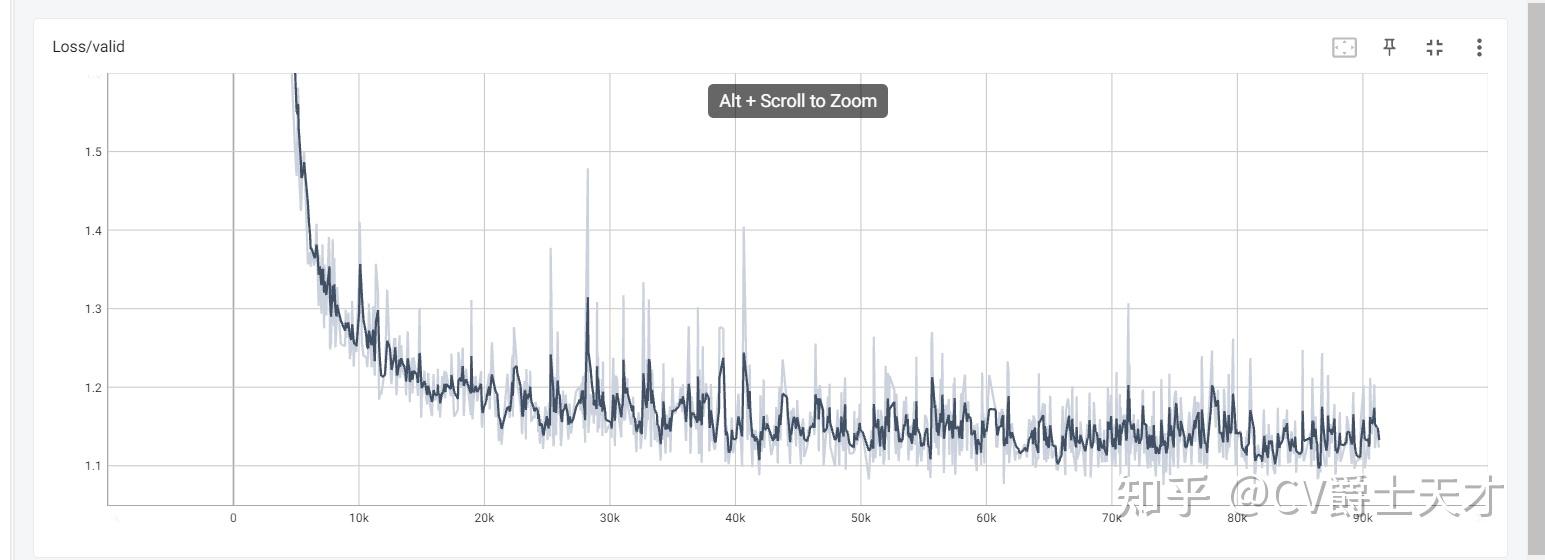|
|
运行环境:pycharm 2022.1
建模的几大步骤:
数据准备、数据预处理,特征工程,建模评估,模型优化
数据准备:
老师给的数据集


数据预处理
1.划分数据集
老师给的数据集只有一个,所以我们需要划分数据集。
# 数据集,验证率,种子
def train_valid_split(data_set, valid_ratio, seed):
'''Split provided training data into training set and validation set'''
valid_set_size = int(valid_ratio * len(data_set))
train_set_size = len(data_set) - valid_set_size
# 划分训练集, 验证集
train_set, valid_set = random_split(data_set, [train_set_size, valid_set_size], generator=torch.Generator().manual_seed(seed))
# 返回np数组
return np.array(train_set), np.array(valid_set)2.先提取目标值和特征值
def select_feat(train_data, valid_data, test_data, select_all=True):
'''Selects useful features to perform regression'''
# 抽取训练集,验证集的最后一列数据作为目标值
y_train, y_valid = train_data[:, -1], valid_data[:, -1]
# 抽取训练集,验证集,测试集的第1到n-1列作为特征值
raw_x_train, raw_x_valid, raw_x_test = train_data[:, :-1], valid_data[:, :-1], test_data
if select_all:
# 如果是全选,特征值的索引是列数0--列数-1
feat_idx = list(range(raw_x_train.shape[1]))
else:
# 如果不是全选,特征值的索引是0--4
feat_idx = [0, 1, 2, 3, 4] # TODO: Select suitable feature columns.
# 返回值是训练集,验证集,测试集的特征值,以及训练集,验证集的目标值
return raw_x_train[:, feat_idx], raw_x_valid[:, feat_idx], raw_x_test[:, feat_idx], y_train, y_valid3.去除异常值
class COVID19Dataset(Dataset):
'''
x: Features.
y: Targets, if none, do prediction.
'''
def __init__(self, x, y=None):
if y is None:
self.y = y
else:
self.y = torch.FloatTensor(y)
self.x = torch.FloatTensor(x)
def __getitem__(self, idx):
if self.y is None:
return self.x[idx]
else:
return self.x[idx], self.y[idx]
def __len__(self):
return len(self.x)4.做特征选择
特征值中并不是所有的特征值对目标值的预测都有用,为了减小计算量,我们筛选出32个与目标值相关性最强的特征值.
# 选取最好的32个特征值
def selected_best(x, y = None):
if y is None:
return x
# 回归任务的标签/功能之间的 F 值
select = SelectKBest(score_func=f_regression, k=32)
z = select.fit_transform(x, y)
# 获取有用特征值的特征
features = select.get_feature_names_out()
print('打印特征名称')
# print(select.get_feature_names_out())
print(z.shape)
return z, features建模评估
1.一个五层神经网络
class My_Model(nn.Module):
def __init__(self, input_dim):
super(My_Model, self).__init__()
# TODO: modify model's structure, be aware of dimensions.
# nn.Sequential可以快速搭建模块
self.layers = nn.Sequential(
# 五个线性层,四个ReLU层
# 五层感知机
nn.Linear(input_dim, 32),
nn.ReLU(),
nn.Linear(32, 8),
nn.ReLU(),
nn.Linear(8, 4),
nn.ReLU(),
nn.Linear(4, 2),
nn.ReLU(),
nn.Linear(2, 1)
)
# forward函数用来进行网络的前向传播,需要传来相应的tensor
def forward(self, x):
x = self.layers(x)
x = x.squeeze(1) # (B, 1) -> (B) 去除size为1的维度
return x2.训练参数
# 设置训练设备,如果GPU能用就用GPU,不能用就用CPU
device = 'cuda' if torch.cuda.is_available() else 'cpu'
# 设置一些训练的参数
config = {
'seed': 5201314, # Your seed number, you can pick your lucky number. :)
'select_all': True, # Whether to use all features.
'valid_ratio': 0.2, # validation_size = train_size * valid_ratio
'n_epochs': 3000, # Number of epochs.
'batch_size': 64,
'learning_rate': 1e-5,
'early_stop': 400, # If model has not improved for this many consecutive epochs, stop training.
'save_path': './models/model.ckpt' # Your model will be saved here.
}3.训练函数
# trainer的参数,训练数据集,验证数据,模型, 配置, 设备
def trainer(train_loader, valid_loader, model, config, device):
# 定义损失函数
criterion = nn.MSELoss(reduction='mean') # Define your loss function, do not modify this.
# Define your optimization algorithm.
# TODO: Please check https://pytorch.org/docs/stable/optim.html to get more available algorithms.
# TODO: L2 regularization (optimizer(weight decay...) or implement by your self).
# 优化器,采用的SGD优化器,使用梯度下降的方法,主要作用是加速模型的收敛,传入的参数有Tensor对象, 学习率,权值衰减
optimizer = torch.optim.SGD(model.parameters(), lr=config['learning_rate'], momentum=0.9)
# 实例化一个SummaryWriter类
writer = SummaryWriter() # Writer of tensoboard.
# 如果项目中没有models这个文件夹,则创建一个
if not os.path.isdir('./models'):
os.mkdir('./models') # Create directory of saving models.
# 设置训练参数
n_epochs, best_loss, step, early_stop_count = config['n_epochs'], math.inf, 0, 0
# 开始训练
for epoch in range(n_epochs):
# 设置需要训练的模型
model.train() # Set your model to train mode.
# 生成损失函数的空列表
loss_record = []
# tqdm is a package to visualize your training progress.
train_pbar = tqdm(train_loader, position=0, leave=True)
# 开始训练
for x, y in train_pbar:
# 优化器的梯度设为0
optimizer.zero_grad() # Set gradient to zero.
# 把需要训练的数据放在GPU或CPU上
x, y = x.to(device), y.to(device) # Move your data to device.
# 获取预测值
pred = model(x)
# 获取预测值和目标值损失函数的值
loss = criterion(pred, y)
loss.backward() # Compute gradient(backpropagation).
# 更新优化器参数
optimizer.step() # Update parameters.
step += 1
# 在损失值得列表中追加这一轮的损失值
loss_record.append(loss.detach().item())
# Display current epoch number and loss on tqdm progress bar.
# 使用tqdm显示出训练过程的进度条
train_pbar.set_description(f'Epoch [{epoch + 1}/{n_epochs}]')
train_pbar.set_postfix({'loss': loss.detach().item()})
# 计算损失值列表的平均损失值
mean_train_loss = sum(loss_record) / len(loss_record)
# 写入Loss/train这个图表中
writer.add_scalar('Loss/train', mean_train_loss, step)
# 设置模型的评估方式
model.eval() # Set your model to evaluation mode.
# 生成损失函数的空列表
loss_record = []
# 验证集开始,过程跟训练集一样
for x, y in valid_loader:
x, y = x.to(device), y.to(device)
# 这一步我也不懂,好像很多模型验证的时候都有
with torch.no_grad():
pred = model(x)
loss = criterion(pred, y)
loss_record.append(loss.item())
mean_valid_loss = sum(loss_record) / len(loss_record)
print(f'Epoch [{epoch + 1}/{n_epochs}]: Train loss: {mean_train_loss:.4f}, Valid loss: {mean_valid_loss:.4f}')
writer.add_scalar('Loss/valid', mean_valid_loss, step)
# 如果验证集的平均损失值小于最小的损失值,则更新最小损失值,并保存最好的模型,停止步骤设置为0,否则停止步骤+1
if mean_valid_loss < best_loss:
best_loss = mean_valid_loss
torch.save(model.state_dict(), config[&#39;save_path&#39;]) # Save your best model
print(&#39;Saving model with loss {:.3f}...&#39;.format(best_loss))
early_stop_count = 0
else:
early_stop_count += 1
# 如果训练400次损失值没有提升,则停止训练
if early_stop_count >= config[&#39;early_stop&#39;]:
print(&#39;\nModel is not improving, so we halt the training session.&#39;)
return测试
测试过程
# 测试
model = My_Model(input_dim=x_train.shape[1]).to(device)
model.load_state_dict(torch.load(config[&#39;save_path&#39;]))
preds = predict(test_loader, model, device)
save_pred(preds, &#39;pred.csv&#39;)
# 预测函数,测试数据, 模型, 设备
def predict(test_loader, model, device):
# model = My_Model(input_dim=117).to(device)
model.eval() # Set your model to evaluation mode.
preds = []
with torch.no_grad():
for x in tqdm(test_loader):
x = x.to(device)
pred = model(x)
preds.append(pred.detach().cpu())
preds = torch.cat(preds, dim=0).numpy()
return preds
# 将预测结果写入文件
def save_pred(preds, file):
&#39;&#39;&#39; Save predictions to specified file &#39;&#39;&#39;
with open(file, &#39;w&#39;) as fp:
writer = csv.writer(fp)
writer.writerow([&#39;id&#39;, &#39;tested_positive&#39;])
for i, p in enumerate(preds):
writer.writerow([i, p])测试结果



CV爵士天才:传染病传播预测模型 |
|